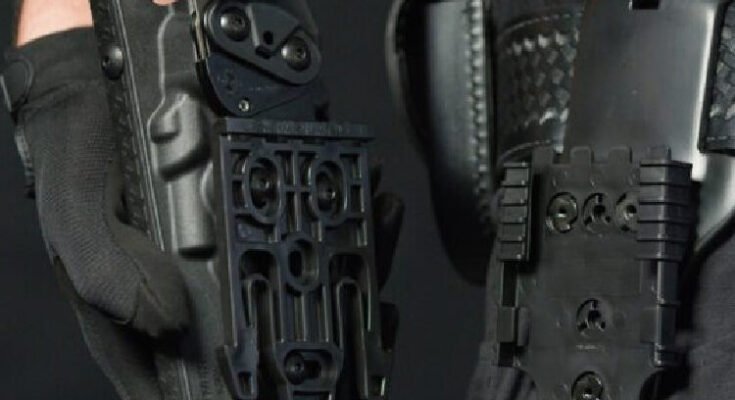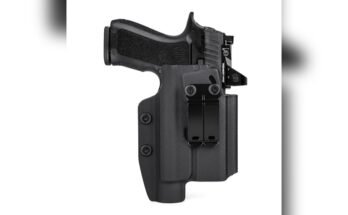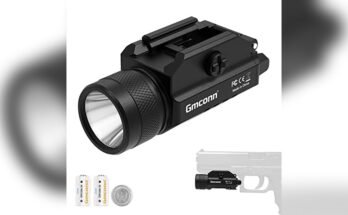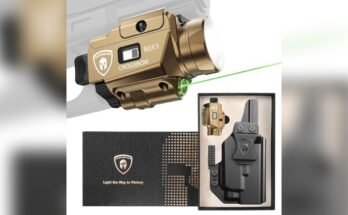If you carry a handgun on the daily or for range days, you’ve likely heard of paddle holsters. I’ve used them in training, teaching, and everyday carry, and I’ve seen what works and what fails. Here’s the short answer: a paddle holster is used for quick on-off carry outside the waistband, strong retention, and stable concealment without needing a belt threaded through loops. If you want comfort and speed with solid retention, a paddle holster can be a smart pick for many users and settings. Read on for a clear, honest breakdown that blends research with real-world use.

Source: www.youtube.com
What Exactly Is A Paddle Holster?
A paddle holster is an outside-the-waistband (OWB) holster with a flat, contoured “paddle” that slips inside your waistband. The holster body sits outside your pants while the paddle hooks or grips the inside of the waistband.
It uses friction, contour, and sometimes small retention hooks to keep the holster in place. Most paddles are made from polymer or reinforced materials. Many models include adjustable cant and ride height to fine-tune draw and comfort.
Because it does not rely on belt loops, you can take it on and off in seconds. That makes it popular for folks who move between “on” and “off” carry several times a day.

Source: www.ebay.com
Core Uses And Real-World Scenarios
Paddle holsters shine when you need fast setup, secure carry, and easy removal. Here are common use cases I’ve seen work well:
- Daily carry with quick on-off: Great when you go from home to office to store and want to clip on and off without unthreading a belt.
- Range training and classes: Easy to adjust between drills, switch holsters, or adapt to different guns.
- Plainclothes or off-duty carry: Offers a balance of concealment and access, especially under a light jacket.
- Home defense staging: Useful when you want a holster you can put on fast and take off when done.
- Vehicle carry: Comfortable for seated positions if set at the right cant and ride height.
I’ve used paddle holsters on long teaching days where I needed to demo, switch positions, and coach. The on-off speed saved time. The wide paddle also spread the weight, which reduced hot spots on the hip.

Source: www.ebay.com
How A Paddle Holster Works: Fit, Retention, And Draw
The paddle sits inside the waistband, using body contour and friction to keep the holster stable. Some paddles have small ledges that catch under the belt for extra hold. The holster shell holds the gun and may use passive retention, active retention, or both.
- Passive retention: Uses friction or a molded “click” around the trigger guard. It should be adjustable by tightening or loosening screws.
- Active retention: Adds a lever, thumb release, or hood you must disengage during the draw. This adds security, especially around crowds or during physical activity.
A good draw should be smooth and repeatable. With proper fit, the holster stays put during the draw stroke and during reholstering.

Source: www.ebay.com
Pros And Cons You Should Consider
Pros:
– Fast on-off convenience: No need to thread a belt every time.
– Comfort and weight spread: The paddle distributes pressure over a larger area.
– Versatile wardrobe: Works with many pants and belts.
– Good for training: Swap holsters or guns with minimal downtime.
Cons:
- Concealment can be harder: OWB can print more under light clothes.
- Stability varies by design: Poor paddles can shift on the draw if not well-made or well-fitted.
- Less secure than dedicated duty rigs: For duty-level retention, a dedicated system may be better.
- Heat and sweat: Larger paddles can trap heat in hot climates.
From experience, the biggest mistake is buying a flimsy paddle with weak hooks or no belt interface. Strong paddles with a textured back and belt catch points hold far better.
Choosing The Right Paddle Holster
Focus on build, retention, and fit to your firearm. Here’s a checklist I use when helping students choose:
- Material quality: Look for durable polymer or kydex with clean molding.
- Retention type: Passive for speed, active for extra security. Many users prefer adjustable passive retention.
- Sweat guard: Helps comfort and protects the gun from sweat.
- Adjustable cant and ride height: Tune to your body and draw style.
- Belt compatibility: Even though it’s a paddle, a firm belt still boosts stability.
- Trigger guard coverage: Must fully cover the trigger for safety.
- Model-specific fit: Holster should be made for your exact firearm and light/optic setup.
Try a few draws in the shop (if allowed). Check that the holster stays in place, the draw is straight, and the reholster is clean and safe.
Concealment, Comfort, And Clothing Tips
Concealment with a paddle holster is about gear and wardrobe working together. You can carry discreetly with the right setup.
- Clothing: Use a slightly thicker cover garment. Hoodies, jackets, or untucked shirts help.
- Positioning: Most prefer 3 to 4 o’clock. Adjust cant forward for easier concealment and draw.
- Belt support: A sturdy belt reduces shifting and printing.
- Holster profile: Slim shells and cut for optics help reduce bulk.
I learned to choose shirts with a bit more structure. They drape better over the holster and hide printing during normal movement.
Safety, Training, And Best Practices
Safety starts with a holster that protects the trigger and stays put. Train a consistent draw stroke and avoid sweeping your body.
- Practice the draw dry first: Keep the muzzle downrange. Focus on clearing the garment, establishing a full firing grip, and pressing straight up and out.
- Mind reholstering: Slow down, look the gun into the holster if safe to do so, and ensure no clothing or cords enter the trigger guard.
- Use the right tension: Set passive retention so the gun won’t shake free yet draws smoothly.
- Check screws and hardware: Thread-lock and routine checks prevent loosening over time.
In training, I’ve seen students over-tighten retention. This causes jerky draws and even holster shift. Find the sweet spot.
Who Should Use A Paddle Holster?
A paddle holster fits anyone who values quick on-off convenience without giving up stability.
- New carriers who want easy setup and comfort.
- Instructors and range-goers who swap gear often.
- Plainclothes security or off-duty users seeking discreet OWB carry.
- Home carriers who gear up quickly for short trips.
If you work in hands-on environments or need duty-level retention, consider models with active retention or a dedicated duty holster.
Care, Maintenance, And Longevity
Clean your holster like any piece of gear. Dust, sweat, and lint can build up over time.
- Wipe down: Use a damp cloth and mild soap. Dry fully before use.
- Inspect hardware: Check belt hooks, paddle texture, and retention screws.
- Replace worn parts: Many brands sell spare hardware kits.
- Test fit after changes: Any adjustment to retention or cant should be followed by a few safe draw reps.
A quick monthly check keeps the holster consistent and reliable.
Frequently Asked Questions Of What Is A Paddle Holster Used For?
Is A Paddle Holster Good For Concealed Carry?
Yes, with the right clothing and cant. A thicker cover garment helps reduce printing. While not as concealable as many IWB options, paddle holsters can conceal well under jackets or loose shirts.
Will A Paddle Holster Stay In Place During The Draw?
A quality paddle with strong hooks and a firm belt will stay put. Set retention correctly and test your draw. Cheaper paddles can shift, which is why build quality matters.
Do Paddle Holsters Require A Gun Belt?
You can use one without a heavy-duty gun belt, but a stiff belt improves stability. I recommend a proper belt for consistent draws and better comfort.
Are Paddle Holsters Comfortable For All-Day Wear?
Many users find them comfortable because the paddle spreads pressure. Comfort depends on holster shape, ride height, and your body type. Adjust cant and try different positions to reduce hotspots.
Can I Use A Paddle Holster For Range Training?
Absolutely. They are popular for training because they’re easy to put on and take off, and they support repeated draws. Ensure safe handling and proper retention settings.
What’s The Difference Between Paddle And Belt-Loop Holsters?
Paddle holsters slip on and off quickly and don’t need you to thread a belt. Belt-loop holsters are slower to mount but may offer even more stability once on. Both can be secure when built well.
Do Paddle Holsters Work With Red Dots Or Weapon Lights?
Yes, if the holster is built for your specific setup. Choose a model molded for your firearm with the optic and light you use.
Wrapping Up Your Best Choice
A paddle holster is used for quick, secure, outside-the-waistband carry that you can put on and take off in seconds. It balances speed, comfort, and retention, which makes it a favorite for range days, daily carry, and training. Pick a quality model, set your retention right, and match it with a good belt and cover garment.
If you’re ready to try one, start with a reputable brand, verify the fit to your exact firearm, and run safe draw drills. Your comfort and confidence will grow fast.
Want more tips and gear guides? Subscribe, share your questions in the comments, and explore our upcoming deep dives on concealment, retention levels, and safe practice routines.
Watch This Video on What is a paddle holster used for?



